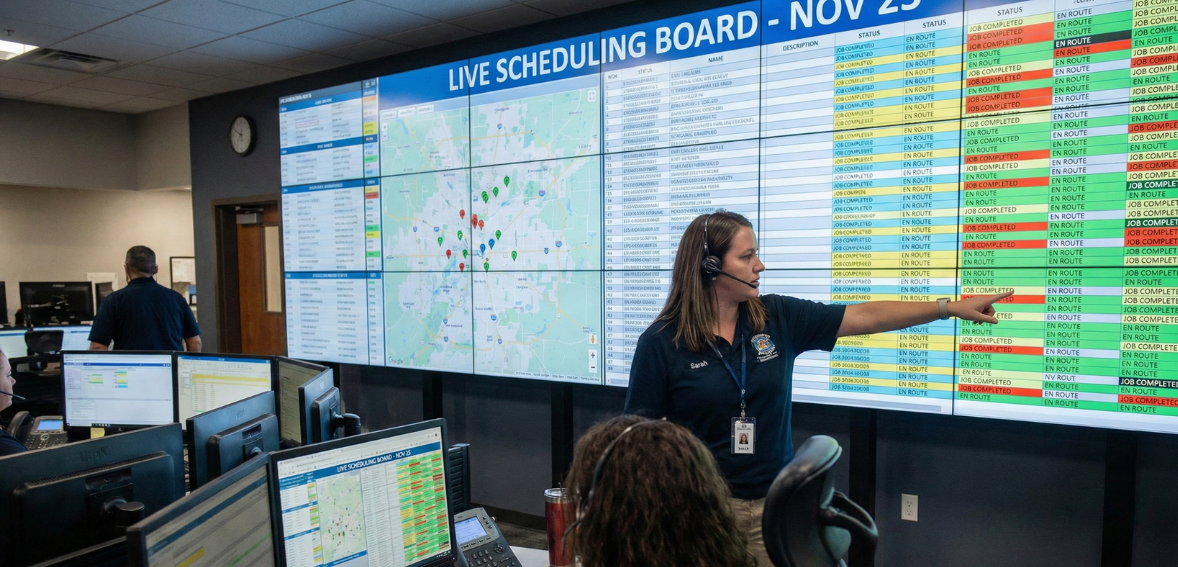
Mastering Field Service Scheduling & Dispatch for Maximum Efficiency in 2025
Field service companies today run on speed, coordination, and precision. When customers need help, whether it’s a malfunctioning HVAC unit or a plumbing emergency, they expect technicians to show up quickly, communicate clearly, and fix it right the first time. That level of service doesn’t come from guesswork, it comes from mastering field service scheduling and dispatch. In 2025, the companies winning the most business are those that have transformed their scheduling systems from a stressful daily struggle into a well-oiled workflow that drives productivity, reduces costs, and keeps customers loyal.
As operations scale, scheduling becomes more complex. Technicians have different skill sets, clients are spread across large service areas, and unexpected emergencies can disrupt the best-laid plans. Without a strong dispatch strategy, technicians may spend more time driving than working, appointments may overlap or get missed entirely, and customers may lose patience due to delays or confusion.
Field service scheduling is no longer simply about assigning jobs to technicians; it is the backbone of modern service performance. When done right, it enhances operational flow, reduces idle time, increases completed jobs per day, and fuels long-term business growth.
This article breaks down the essential elements of mastering field service scheduling and dispatch. From intelligent workflow planning to real-time communication upgrades and smart automation that adapts to conditions instantly, field service leaders can reshape their operations into an efficiency powerhouse. Let’s explore how strong scheduling practices make all the difference.
Table of Contents
ToggleWhy Effective Field Service Scheduling Is Now Business Critical

Every minute a technician spends waiting for information, stuck in traffic, or going to the wrong job is a minute the business is losing money. When field service scheduling and management is well-designed, technicians arrive prepared, on time, and ready to resolve the issue. This boosts first-time resolution rates, reduces operational costs, and significantly improves customer satisfaction. A single bad dispatch decision can trigger a chain reaction delayed appointments spill into later timeslots, frustrated customers call repeatedly for updates, and technicians end their shift exhausted with overtime costs stacking up.
Efficiency directly influences profitability. Travel time is a cost. Gaps in the schedule are lost earning opportunities. Miscommunication leads to return visits. In a competitive market, speed and accuracy often set a company apart from its competitors. A homeowner needing a repair won’t wait days if another provider offers same-day arrival with real-time tracking. Modern customers expect convenience. They expect transparency. And companies that deliver both through optimized field service scheduling are the ones securing repeat customers and strong reviews.
Scheduling is no longer a clerical task; it is a core operational strategy that informs workforce utilization, customer experience standards, and even brand reputation. Businesses that treat dispatch like a strategic function rather than a reactive exercise set themselves up for success.
Building a Centralized Scheduling Framework That Eliminates Chaos

In many smaller service companies, dispatch responsibilities fall to one person, who juggles phone calls, text messages, technician availability, and customer expectations all while manually updating the schedule. But manual systems introduce errors and create bottlenecks. A centralized framework consolidates scheduling data into a single source of truth. This means information flows consistently through one channel rather than being scattered across emails or sticky notes.
A centralized schedule allows dispatchers to instantly see who is available, where they are, and which skills they possess. It reduces the chance of double-booking, sending the wrong technician to a specialized job, or missing appointments entirely. It also supports scalability; the same dispatcher who used to manage a handful of technicians can now confidently oversee a larger team without adding operational stress.
When field service scheduling occurs on a single platform, adjustments are faster and more intelligent. A new emergency call arrives? The dispatcher can identify the closest qualified technician in seconds. A job takes longer than expected? The next appointment can be reassigned or rescheduled before delays pile up. Operating from a unified system turns scheduling into a fluid process that adapts moment to moment rather than collapsing under pressure.
Route Optimization: Reducing Drive Time, Increasing Profit

One of the most significant hidden expenses in field service operations is travel. Every mile costs fuel, increases vehicle wear, and reduces the number of jobs technicians can complete in a day. Poor routing may seem small at the moment, but over weeks and months, it becomes a major financial leak. Using route optimization in field service scheduling helps minimize unnecessary costs.
Efficient route planning does more than shorten drive times. It improves punctuality, meaning customers aren’t left waiting or calling repeatedly for status updates. When technicians arrive on time, without the stress of rushing between jobs, their service quality improves. Route optimization also reduces scheduling conflicts by building realistic job sequences that account for distance and time constraints.
In busy seasons when demand spikes, optimized routes enable businesses to accept more appointments without turning new customers away. More assignments completed per shift equals more billing and stronger revenue performance. Companies that fail to optimize routing often end up with overloaded technicians, wasted hours behind the wheel, and frustrated customers left waiting for delays. Smart routing turns mobility from limitation to advantage.
Scheduling Based on Technician Skill, Experience, and Tools

A core rule in field service scheduling: not all technicians are interchangeable. Sending a generalist to solve a complex HVAC issue or a rookie to diagnose advanced electrical failures results in more extended visits, lower fix rates, and repeat dispatches wasting time for both customers and workers.
Skill-based scheduling ensures the right technician is matched with the right job from the start. This reduces the need for escalation calls and boosts productivity because the worker arriving on-site has the exact knowledge, certifications, and tools required. Even within the same specialty, experience matters. A new hire may complete an installation in twice the time it takes a seasoned technician. A good dispatcher understands this and adapts accordingly.
Overassigning complex tasks to senior technicians is equally inefficient, leading to burnout and bottlenecks. Intelligent scheduling distributes workloads in a balanced way, using senior techs for specific high-impact issues while allowing mid-level workers to grow their capabilities through suitable assignments.
Knowing a technician’s strengths, weaknesses, locations, and equipment availability enables dispatchers to consistently align the right resources with each customer’s needs. When skill matching becomes standard practice, operational performance improves almost instantly with more first-time fixes, shorter job durations, and better utilization of the entire workforce.
Real Time Updates & Communication: Keeping Everyone Aligned

Even the most carefully crafted schedule can fall apart if technicians and customers don’t receive timely updates. Field service dispatching depends on real-time communication, not a morning print-out that becomes outdated the moment a job takes longer than expected. When a technician finishes early, a customer becomes suddenly unavailable, or a part is missing, adjustments must be made instantly. Real-time updates ensure that what’s on the screen always matches what’s happening in the field.
Technicians feel more confident when they know exactly where they’re going next, what equipment is needed, and who to contact. Customers feel respected when they receive arrival updates, the technician’s name and photo, and transparent ETAs instead of vague waiting windows. When communication flows smoothly, nobody is surprised or confused, and everyone feels taken care of. It turns field service scheduling from a guessing game into a coordinated experience.
Flexibility & Rapid Response: Planning for the Unexpected

No matter how perfect the plan looks in the morning, real life brings unexpected challenges. Weather delays, traffic jams, emergency breakdowns, sick technicians field service teams have to respond fast. The best schedules are not rigid; they’re adaptable. They include small time buffers to absorb unpredictable events and workflows that support quick reassignment when necessary.
A flexible dispatch strategy allows high-urgency calls like a furnace failure during cold weather or a burst pipe to be prioritized within minutes. Instead of derailing the whole day, the dispatcher can reshuffle tasks, redirect the nearest skilled technician, and keep the customer calm with clear updates. Flexibility builds resilience. It ensures that even when disruptions occur, technicians stay productive and customers still feel valued.
Businesses that embrace adaptable field service scheduling outperform those stuck in rigid routines. They accept change as part of the work and build systems that keep operations strong, no matter what the day brings.
Using Analytics to Improve Scheduling Over Time

Efficiency is not a one-time achievement; it’s something that improves with data. Field service scheduling can reveal powerful insights about how a team works. Analytics help identify which technicians consistently complete more jobs, where travel delays occur most frequently, which time slots attract the most urgent calls, and which job types are most likely to require follow-ups.
When leaders can see patterns, they can correct weaknesses. A technician who struggles with complex installations might need additional training. A service area that constantly suffers traffic delays may need re-zoning. A job type that always runs long may require longer time blocks on the schedule. Data turns scheduling from reactive to strategic.
Companies that measure performance don’t just manage the day they shape the future. Analytics create a feedback loop that continually raises productivity, improves customer experiences, and increases profitability across the organization.
Balancing Workload Stress and Technician Well-Being Through Smarter Scheduling
No matter how efficient a schedule looks on paper, technicians are still human. When the workload becomes overwhelming too many jobs per day, long driving distances, rushed appointments performance gradually declines. Mistakes become more common, customer interactions become less friendly, and turnover risk increases. Field service scheduling isn’t only a logistics system; it’s a tool that shapes the daily reality of the people doing the work.
A balanced schedule respects technician limits and focuses on sustainable productivity. When dispatchers distribute tasks fairly based on capacity, experience, and proximity, technicians feel less stressed and more engaged. Predictable workloads reduce burnout, and reasonable time blocks give them space to do quality work instead of racing the clock. Happiness in the field leads to better customer reviews, more repeat business, and stronger loyalty within the team.
Smarter scheduling acknowledges that well-being is not a luxury; it is essential to operational success. When employees feel equipped and valued, every interaction with a customer becomes more positive and every completed job becomes a reflection of a company that truly supports the people who represent it every day.
Conclusion
Mastering field service scheduling is not about filling a calendar, it’s about unlocking operational excellence. The right strategy helps technicians stay focused on doing what they do best: solving problems and serving customers. Every improvement in scheduling whether it’s optimizing routes, making smarter skill assignments, or communicating in real time directly boosts revenue, efficiency, and satisfaction.
Businesses that embrace modern scheduling techniques will complete more jobs each day, reduce wasted time, and build a trusted reputation for reliability. In a service industry where customers expect speed and professionalism, strong dispatching becomes the silent engine that drives success. With real-time flexibility, performance analytics, and thoughtful planning, field service scheduling transforms into a competitive advantage that will define the most successful service companies of 2025 and beyond.
By embracing smart scheduling, transparent communication, and powerful tools like Scheduling Software, you aren’t just improving your workflow, you are building a business that can scale with confidence. Because in the HVAC industry, the ultimate goal isn’t just fixing systems for others; it’s building a perfect system inside your own company that keeps everything running flawlessly, every single day.
FAQs
Why is efficient scheduling so critical in field service?
Because time is money, optimized scheduling increases productivity, reduces overtime, and ensures faster response times, helping retain customers and improve first-time-fix success rates.
How can I reduce travel time and fuel costs for technicians?
Use routing strategies that prioritize distance, traffic, and skill requirements. Efficient route planning shortens driving time, allowing technicians to spend more hours on revenue-generating work.
What is the best way to handle emergency or urgent jobs?
Keep flexible schedule slots and prioritize high-impact calls immediately. Rapid reassignment helps solve emergencies without causing significant delays to other appointments.
Can automation really improve dispatch performance?
Absolutely. Automation eliminates human delays and ensures the right technician gets the proper job assignment faster, leading to smoother schedules and fewer missed appointments.
How do I keep customers accurately informed during the scheduling process?
Provide automatic appointment confirmations, live arrival tracking, and ETA updates. Clear communication reduces customer stress and prevents no-access situations.
